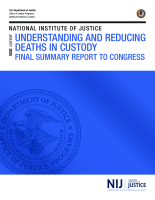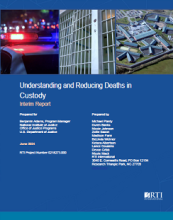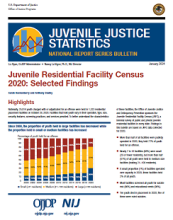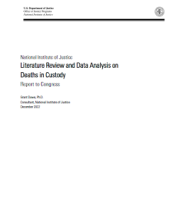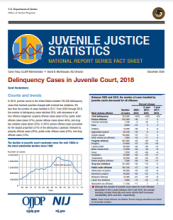Deaths in custody
Understanding and Reducing Deaths in Custody: Final Research Report
Understanding and Reducing Deaths in Custody, Interim Summary Report
Understanding and Reducing Deaths in Custody, Interim Report
Excitation Study: Unexplained In-Custody Deaths: Evaluating Biomarkers of Stress and Agitation
Juvenile Residential Facility Census, 2020: Selected Findings
Dying Inside: Litigation Patterns for Deaths in Jail Custody
National Institute of Justice Literature Review and Data Analysis on Deaths in Custody, Report to Congress
Reducing Deaths in Law Enforcement Custody: Identifying High-Priority Needs for the Criminal Justice System
Positional Asphyxia--Sudden Death
Mortality in Correctional Institutions (Bureau of Justice Statistics)
Collects incarcerated person death records from each of the nation's 50 state prison systems, Federal Bureau of Prisons, and approximately 2,800 local jail jurisdictions. Between 2003 and 2014, BJS also collected data on persons who died while in the process of arrest.
Formerly Deaths in Custody Reporting Program.
Arrest-Related Deaths (Bureau of Justice Statistics)
The Arrest-Related Deaths (ARD) component of Mortality In Correctional Institutions (MCI) (Formerly Deaths In Custody Reporting Program (DCRP) is a national census of all manners of arrest-related deaths and includes all civilian deaths that occurred during, or shortly after, state or local law enforcement personnel engaged in an arrest or restraint process.
Federal Law Enforcement Agency Deaths in Custody Reporting Program (Bureau of Justice Statistics)
The Death in Custody Reporting Act of 2013 (DICRA) requires the head of each federal law enforcement agency to submit to the U.S. attorney general, information about the death of any person who is
Juvenile Residential Facility Census, 2018: Selected Findings
Medical Panel Issues Interim Findings on Stun Gun Safety
Sentinel Events Approach to Jail Suicide and Self-Harm
Are CEDs Safe and Effective?
Thousands of law enforcement agencies throughout the United States have adopted conducted energy devices (CEDs) as a safe method to subdue individuals, but are these devices really safe? What policies should agencies adopt to ensure the proper use of this technology? This NIJ Conference Panel discusses the physiological effects of electrical current in the human body caused by CEDs, as well as how this technology can reduce injuries to officers and suspects when appropriate policies and training are followed.



